Balbharti Maharashtra State Board Class 9 Geography Solutions Chapter 10 Urbanisation Human Notes, Textbook Exercise Important Questions and Answers.
Maharashtra State Board Class 9 Geography Solutions Chapter 10 Urbanisation Human
Class 9 Geography Chapter 10 Urbanisation Human Textbook Questions and Answers
1. Suggest measures for the following problems:
(A) The slums in the cities are increasing.
Answer:
- Creating more job opportunities in the rural areas so that migration is minimised.
- Poverty alleviation schemes need to be implemented to improve the standard of living of the poor.
- Initiative for improvement of sanitation, housing and other facilities must be facilitated.
![]()
(B) Because of the increasing traffic jams within the city, lot of time is consumed in commuting.
Answer:
- To reduce traffic jams, carpooling is a great way to get to and fro work.
- Planning the route in advance will help to avoid any road construction or other traffic jams.
- Making use of public transportation like Railways, BEST, etc. will also help in reducing traffic congestion and precious fuel.
(C) The question of law and order in the urban areas is serious.
Answer:
- Many crimes are due to poverty and unemployment. Poverty alleviation and employment generation programmes should be given priority.
- The semi-literate / educated unemployed persons should be given skill-training and be prepared for self-employment.
- The police and the judicial system “should be strengthened to wipe out criminals.
(D) The problem of pollution is grave because of urbanisation.
Answer:
- Walking or cycling to the work place will not only help in improving the health conditions of individuals but will also help in reducing pollution.
- Cities need to green up (plant more trees) as trees are considered to be the natural purifiers.
- Strict action should be taken against polluting industrial units.
(E) Migration has created questions of health and education in urban areas.
Answer:
- Migration from rural to urban areas can be reduced if employment opportunities are provided in the rural areas.
- Infrastructure like transport, electricity, public distribution system, etc. need to be provided in the rural areas.
- Educational institutes and health centres need to be upgraded in the rural areas.
![]()
2. Match the correct pairs :
Group A – Group B
(1) Technological development and mechanization – (A) Urban areas
(2) Permanently staying away from your original place – (B) Lack of planning
(3) 75% males are engaged in non-agricultural occupation – (C) Migration
(4) The problems of solid waste – (D) Urbanisation
Answer:
(1-d),
(2- c),
(3 – a),
(4 – b)
3. Outline the importance/ advantages of the following:
(A) Technology and mechanisation
Answer:
- Technology and mechanisation increase industrial production, creates employment and is useful for urbanisation.
- In recent decades, the use of technology and mechanisation has increased in agriculture.
- Due to the mechanisation of agriculture, the surplus manpower employed in agriculture have become devoid of agricultural work.
- This working class started coming to cities to look for work and as a result urban population started increasing.
(B) Trade
Answer:
- When a place in a region is favourable in terms of transport, loading-unloading and storage of goods, it developes into a trade centre.
- This leads to the growth of business complexes, banks, credit societies, godowns, cold storage, houses, etc.
- For example, Nagpur’s central location has facilitated trade and hence urbanisation has also taken place here.
(C) Industrialisation
Answer:
- Industrialisation leads to increase in the hopes of people who are attracted towards the industries from surrounding areas for employment.
- Rapid growth of Mumbai in the 19th century was due to the textile mills which were started here.
- Many fishing villages (Koliwadas) became part of Mumbai metropolitan2 area due to industrialisation and urbanisation.
![]()
(D) Amenities in urban areas
Answer:
- Urbanisation leads to development of a number of amenities and facilities in urban areas.
- Transportation, communication, educational facilities, medical facilities, fire brigade, various sources of entertainment, etc. are examples of amenities in urban areas.
- A good transportation not only makes a journey easier but also has a positive effect on freight transport, development of markets, trade, etc.
- Development of higher educational facilities in urban areas attract students from rural areas to urban areas. E.g. Pune.
- Development of high quality medical facilities in urban areas bring many patients and their family members from different parts of India to these areas.
(E) Social harmony in the cities
Answer:
- Social harmony refers to the exchange of cultural and social customs and traditions as people from different parts live together in the cities.
- An increase in urbanisation leads to an increase in secondary, tertiary and quaternary occupation.
- This results in an increase in employment opportunities due to which people from different parts of the country come to cities and there is an exchange of customs and traditions.
4. Compare the following and give examples:
(A) Transportation system and traffic jams
Answer:
- As cities grow, people start living on the outskirts and in the suburbs of the city.
- People commute to the centre of the city for businesses and industries, trade, jobs, education, etc.
- Public transportation system is insufficient and hence the number of private vehicles increase.
- This results in an increase in traffic jams and a lot of time is consumed in travelling from one place to another.
e.g. Although Mumbai has a well developed transportation system it is insufficient to fulfil the growing needs of people.
Hence, traffic jams are a frequent site in different pockets of Mumbai.
(B) Industrialisation and air pollution
Answer:
- Industrialisation refers to the growth in number of industries in a particular region.
- As more and more industries crop up, it becomes convenient for the industries to violate the environmental laws.
- Paucity of facilities, insensitivity towards environment are the other factors which leads to an increase in the pollution level.
- Hence, Industrialisation and Air pollution are the two aspects of the same coin.
e.g. Delhi, Faridabad and Varanasi are the ! victims of rapid industrialisation leading to j severe air pollution.
![]()
(C) Migration and slums
Answer:
- The increase in the number of migratory people causes an increase in the slums.
- Generally migration from rural to urban areas takes place in search of job opportunities, which are hard to find.
- The housing facilities do not increase in the same proportion as the population, so the poor migrants can not afford the housing in the cities.
- This encourages the migrants to build illegal temporary and semi-structured houses known as slums, in open spaces. e.g. Slums in Dharavi (Mumbai city)
(D) Amenities and increasing crime
Answer:
- Amenities refers to facilities that provide comfort, convenience or pleasure to people.
- Transportation, communication, educational and medical facilities, fire brigade, etc. are the examples of amenities available in urban areas.
- Unemployed people who have migrated to the cities are unable to avail these amenities.
- This leads to an increase in thefts, burglaries, scuffles5, murders, etc. which disturb the social harmony of the cities.
e.g. Pick pocketing in the local trains.
5. Complete the table :
| Process of urbanisation | Effects |
| Emergence of slums | Illegal settlements Insufficient facilities |
| Increase in population because of attraction of good lifestyle Can be short-term or long-term | |
| Pollution | |
| Employment opportunities were generated Increase in amenities and facilities | |
| Change from rural to urban |
Answer:
| Process of urbanisation | Effects |
| Emergence of Slums | Illegal settlements Insufficient facilities |
| Migration | Increase in population because of the attraction of good lifestyle. Can be short-term or long term. |
| Pollution | Adverse effects on urban life. |
| Industrialisation | Employment opportunities have generated, increase in amenities and facilities. |
| Change from rural to urban | Formation of Municipal Corporation. better civic amenities, development of occupations. |
6. Explain:
(A) The growth of cities takes place in a specific method.
Answer:
Villages are transforming into cities. The growth of cities take place in a particular pattern.
- At first various industries like factories, mills, energy plants, multi-purpose projects3 etc., come up in rural areas.
- People from surrounding areas come to work here and the population of the village increases.
- To fulfill their needs other services develop like medical facilities, food, hospitals, recreation, etc.
- The Gram Panchayat gives way to a Municipal Corporation.
- These bodies provide basic services to citizens like drinking water, roads, transportation, sewerage network, street lighting etc.

- Other facilities develop like town planning recreation facilities, tourist places, parks etc.
(B) A planned city of your imagination
Answer:
- A city which is carefully planned from its inception and is constructed in a previously undeveloped area is a planned city.
- A planned city is one in which there is adequate infrastructural facilities like roads, railways, water supply, power supply, etc.
- Also, there should be open spaces available for recreation facilities.
(C) Industrialisation causes cities to develop.
Answer:
- The development and concentration of industries in a region is a factor contributing towards urbanisation.
- Increase in industries leads to increase in the hopes of people who are attracted towards these industries from surrounding areas.
- An increase in population leads to the development of infrastructural facilities like roadways, railways, power supply, water supply etc. which are the characteristics of a planned city.
- In the 19th century, Mumbai grew rapidly because textile mills started on a large scale.
(D) Pollution- A problem
Answer:
- Pollution is the introduction of contaminants into natural environment that causes adverse changes.
- Pollution can be that of air, water, noise, solid waste, etc.
- Pollution can adversely affect the human health.
- Water pollution can lead to several water borne diseases like typhoid, cholera etc. Air pollution can lead to asthma and other respiratory diseases. Noise pollution can lead to sleep disturbance, hearing impairment etc.
(E) Swachchh Bharat Abhiyan
Answer:
- Swatch Bharat Abhiyan is a cleanliness campaign run by the Government of India.
- ‘One step towards cleanliness’ is the objective of this campaign.
- This campaign aims to keep the streets and infrastructure of the country’s cities, towns and its rural areas clean.
- The funds for this programs are raised by ‘Swachchh Bharat Cess’.
![]()
7. Suggest measures for the following problems of urbanisation shown in the following pictures.
(1) Air Pollution:

Answer:
- Switching from coal, oil to natural gas as fuel in the industries.
- Industrial areas should be located at a safe distance from residential areas.
(2) Noise Pollution:
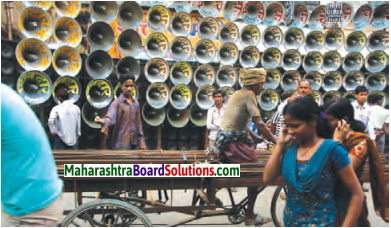
Answer:
- Follow the limits of noise level.
- Shut the door when using noisy machines.
- To restrict noise pollution lower the volume of horns, loudspeakers, etc.
(3) Solid Waste Pollution:
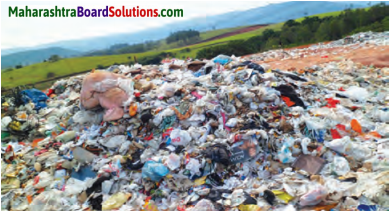
Answer:
- Avoid disposing and littering of solid waste in the open.
- Follow the principle of 4 R’s (Reduce, Recycle, Repair and Reuse) for non-biodegradable things.
- Segregation of dry waste and wet waste for proper disposal.
(4) Water Pollution:

Answer:
- Sewage should not be allowed to mix with water sources without getting treated.
- Avoid mixing industrial wastes and effluents directly into water sources.
- Daily household chores should be avoided at water sources.
![]()
Class 9 Geography Chapter 10 Urbanisation Human Intext Questions and Answers
Can you tell?
Question 1.
Answer the following questions.
(i) Why is Suresh thinking of going to the factory for work?
Answer:
- Suresh is thinking of going to the factory as it will get him a monthly salary.
- Also, if he works overtime, he will get additional money and a bonus during Diwali.
Question 2.
What is Tatya worried about?
Answer:
- Tatya is worried about the availability of labour in the agricultural field, since his son (Suresh) has decided to work in the factory.
- Also, he is worried whether his son can manage working in the field and the factory simultaneously.
Question 3.
What changes does Suresh think will occur in the village?
Answer:
- Development of goods and facilities like hospitals, schools and colleges, administrative offices, huge buildings are expected in the village.
- The above factors will lead to migration of people from different villages which will bring about rural development.
Question 4.
What other changes do you think will occur in the village?
Answer:
There “will be well planned drainage systems, pure drinking water supply, street lightning, concrete roads, public library, etc. amenities will be provided. There will be fire station to control fires, police stations to control crimes. These changes are likely to occur in the village.
Give it a try.
Question 1.
Give example of villages in your area turning into urban settlement.
Answer:
- Airoli, Nerul, Kopar Khairane, Vashi, Panvel, Taloja, Kamothe etc which comprises of Navi Mumbai (New Bombay) are the examples of villages turning into urban settlement.
Question 2.
Find out the main reason of that rural area turning into urban settlement.
Answer:
City and Industrial Development Corporation (CIDCO) planned and constructed all the railway stations, roads and public spaces in Navi Mumbai. APMC (Agricultural Produce Market Committee) which is a wholesale agricultural produce market at Vashi and Construction of Commuter railway line from Mankhurd to Vashi led to growth in economic activities and population in Navi Mumbai.
![]()
Question 3.
Obtain information regarding development of settlements, villages, towns, etc. located on the main transport routes in your surroundings in the last five years.
Answer:
In Mumbai along the Metro station route there are 2 settlements which have developed. They are Asalpha and Jagruti Nagar. Neither were very well-known places five years ago. But today they are important metro stations.
Question 4.
Make a list of cities in your district.
Answer:
I live in Thane District – Two of the cities are:
- Bhiwandi
- Badlapur.
Question 5.
Discuss which factors from above are responsible for their development.
Answer:
Factors responsible for development are:-
- Bhiwandi – Industrialisation (Textile industry)
- Badlapur – Transport (Connected to Mumbai – Pune expressway, has railway station on Mumbai – Pune route)
Question 6.
If possible, talk to people who have migrated in your surroundings or the nearest town and find out reasons of migration.
Answer:
People have migrated from Mumbai to Navi Mumbai.
The reasons are:
- Better town planning
- Better standard of living
Write five sentences on each picture after observing them.
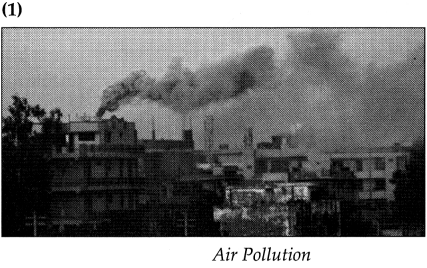
Answer:
- In this picture the harmful gases, smoke released by the factory is causing air pollution.
- Any substance that is introduced into the atmosphere and has damaging effects on living things and the environment is called Air Pollutant.
- Air Pollution occurs when any harmful gases, dust, smoke enters into the atmosphere.
- Air Pollution can lead to asthma, respiratory inflammation, decrease in living functioning and other respiratory diseases in humans.

- The Ozone layer on the planet is depleting due to increased Air Pollution.
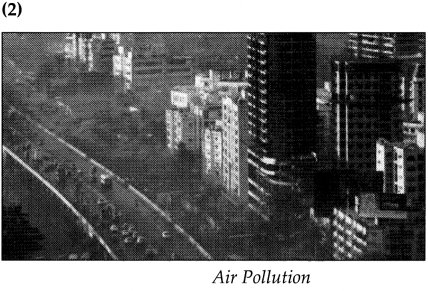
Answer:
- The picture shows heavy smog in a city causing air pollution.
- Smog is a combination of smoke and fog.
- Usually smog results from large amounts of coal burning in an area and is caused by a mixture of smoke and Sulphur dioxide.
- It is a big problem in Beijing and New Delhi.
- Smogs cause lung diseases.
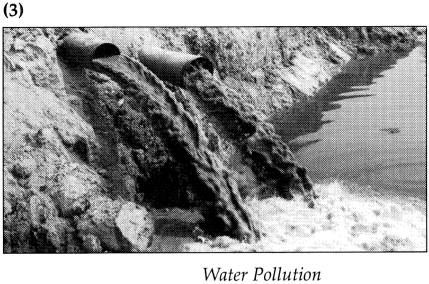
Answer:
- In this picture we can see untreated polluted water being released into a river causing water pollution.
- Water pollution is the contamination of water . bodies like lakes, rivers, oceans, etc.
- Almost 80% of water pollution is caused by domestic sewage.
- Water pollution can lead to several waterborne diseases like typhoid, cholera, dysentery, jaundice and malaria.
- Water pollution affects marine life and the environment.
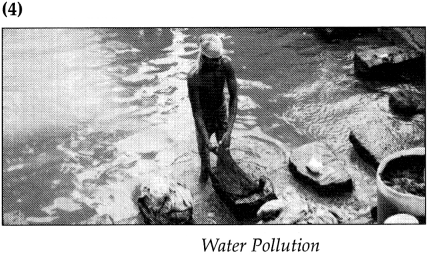
Answer:
- The picture shows a washerman washing clothes in a pond, thus polluting the water.
- The soap and detergent used in bathing or washing contains certain chemicals which can pollute the water.
- Water pollution affects the aquatic life.

- Water pollution is a big menace to the economy, the environment and human health.
- We should raise the awareness among the people about the causes and effects of water pollution.
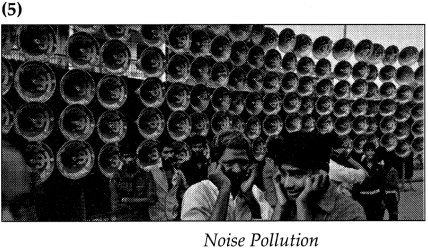
Answer:
- In this picture we can see people are affected due to noise pollution caused by the loudspeakers.
- Noise pollution is excessive noise that harms the balance of human or animal life.
- Outdoor noise can be caused by machines, construction activities, vehicular traffic, sound of train or aircrafts, loudspeakers, etc.
- Noise pollution can cause hypertension, high stress levels, hearing loss, sleep disturbances, etc.
- Thus noise pollution affects both health and behaviour.
Observe the image and answer the following questions?

(i) What does the symbol signify?
Answer:
The symbol signifies an Indian Government campaign called ‘Swachh Bharat Abhiyan’, or ‘Clean India Movement’.
(ii) Obtain information regarding it through internet.
Answer:
- Swachchh Bharat Abhiyan is a cleanliness campaign run by the Government of India.
- The campaign involves the construction of latrines, promoting sanitation programmes in the rural areas, cleaning streets, roads and changing the infrastructure of the country to lead the country ahead.
- It is launched as a responsibility of each and every citizen to make this country a Swachh country.
- It was launched by Prime Minister Narendra Modi on the 145th birth anniversary of Mahatma Gandhi on 2nd October, 2014 at Rajghat, New Delhi.
![]()
(iii) Write how this programme is related to your daily life.
Answer:
In our daily life we see that in the rural and urban areas people are openly defecating, due to lack of latrines. This is not only an ugly sight, but also there are many adverse effects to it. There is a risk of contracting many diseases. Also it is unsafe for women and young girls.
Think about it.
Question 1.
Which facilities are necessary to be developed in urban areas for fulfilling the needs of the population?
Answer:
Facilities necessary to be developed in urban areas for fulfilling the needs of the population are:
- Adequate water supply
- Proper sewage system
- Better means of transportation
- Regular power supply
- Sanitation
- Health care centres
- Schools and colleges.
Question 2.
Why do the sources of water near the city get polluted?
Answer:
The sources of water near the city gets polluted due to garbage from construction sites, and industrial areas, improper disposal of hazardous materials from garbage disposal companies, chemical spills and improper chemical disposal, sewage leaks, etc.
Question 3.
How is the polluted water disposed off in the cities?
Answer:
Almost 80% of the water pollution is caused by domestic sewage. This untreated sewage mixes with the various water bodies and causes water pollution.
Question 4.
Is the water supplied to the cities good for health?
Answer:
- The cities have a chlorinated central water supply, managed by the government. But people living in illegal slums have been unable to legally connect to this system.
- This forces many of them to illegally tap into city water pipes.
- This has compromised the safety of the water supply through cross-contamination in many places.
![]()
Question 5.
What are the adverse effects of water, air and noise pollution on health?
Answer:
Pollution affects the health adversely. The effects are:
- Water pollution can lead to several water borne diseases like typhoid, cholera, dysentery, jaundice and malaria.
- Air pollution can lead to asthma, respiratory inflammation, lung functioning diseases and other respiratory diseases.
- Noise pollution can lead to hearing impairment, hypertension, sleep disturbance and so on.
Use your brain power!
Write a paragraph suggesting measures of these problem of urbanisation.
Question 1.
When heaps of wastes accumulate bad odour and diseases are spread.
Answer:
- To reduce the heaps of wastes reusable bags and containers must be used for shopping, travelling or packing lunches or leftovers.
- Food scraps and garden waste can be combined to form compost.
- Buy items made of recycled content and use and reuse them as much as you can.
Question 2.
Traffic jams are a regular routine.
Answer:
- To reduce traffic jams, carpooling is a great way to get to and from work.
- Planning the route in advance will help to avoid any traffic jams.
- Making use of public transportation like railway, BEST etc will also help in reducing traffic congestion and precious fuel.
![]()
Find out.
Question 1.
Look for the changes that have occurred in the technology and mechanisation of agriculture with the help of internet. Write a short paragraph about the information you obtain.
Answer:
Mechanisation was one of the main factors responsible for urbanisation and industrialisation. Besides improving the production efficiency, mechanisation encourages large scale production and also improves the quality of production. On the other hand, mechanisation also displaces unskilled farm labour and causes environmental degradation (such as pollution, deforestation and soil erosion).
Try this.
Question 1.
Using the industrial information given in the table below, draw a line graph of the percentage of urban population. Discuss in terms of urbanisation. After studying this graph write the conclusion about urbanisation in our country from 1961-2011 in your own words.
Answer:
Observations:
- The urban population has been increasing consistently from 1961 to 2011.
- The growth of urban population was about 5.5 % from 1961 to 1981.
- However, the growth of urban population was to 13.7% from 1981 to 2011.
- Industrialisation, trade, mechanisation and technology, transport and communication and migration are factors responsible for increase in urban population.
Class 9 Geography Chapter 10 Urbanisation Human Additional Important Questions and Answers
Complete the statements choosing a colored option from the bracket:
Question 1.
In India is the main occupation.
(a) Industries
(b) Agriculture
(c) Banking
(d) Fishing
Answer:
(b) Agriculture
Question 2.
provides public service to the village.
(a) Gram Panchayat
(b) Municipal Council
(c) Government of India
(d) Army
Answer:
(a) Gram Panchayat
![]()
Question 3.
or provides public service to the urban areas.
(a) Municipal Council / Municipal Corporation
(b) Gram Panchayat / Gram sabha
(c) High Court / Supreme Court
(d) Government of India
Answer:
(a) Municipal Council or Municipal Corporation
Question 4.
Census of India decided to define ‘Urban’ in the year
(a) 1951
(b) 1961
(c) 1971
(d) 1981
Answer:
(b) 1961
Question 5.
For an urban area more than of the male working population must be engaged in non-agricultural occupation.
(a) 70%
(b) 75%
(c) 80%
(d) 85%
Answer:
(b) 75%
Question 6.
For an urban area, the population of the settlement should be more than
(a) 3000
(b) 4000
(c) 5000
(d) 6000
Answer:
(c) 5000
Question 7.
For an urban area, the density of population should be more than persons per sq.km.
(a) 400
(b) 300
(c) 500
(d) 700
Answer:
(a) 400
![]()
Question 8.
The growth of population from 1961 to 1981 was around
(a) 3.2%
(b) 4.3%
(c) 5.5%
(d) 6.5%
Answer:
(c) 5.5%
Question 9.
The growth of population from 1981 to 2011 was around
(a) 12.73%
(b) 14.73%
(c) 13.73%
(d) 12.83
Answer:
(c) 13.73%
Question 10.
The development and concentration of industries in a region is a factor contributing towards
(a) industrialisation
(b) mechanisation
(c) urbanisation
(d) agriculture
Answer:
(c) Urbanisation
Question 11.
In 19th century Mumbai grew rapidly because of
(a) shopping malls
(b) textile mills
(c) service industries
(d) agriculture
Answer:
(b) Textile mills
Question 12.
is a centrally located part of India.
(a) Nagpur
(b) Bhopal
(c) Bilaspur
(d) Pune
Answer:
(a) Nagpur
![]()
Question 13.
In the recent decades, the use of technology has increased in
(a) industries
(b) service
(c) agriculture
(d) engineering
Answer:
(c) agriculture
Question 14.
Manpower employed in agriculture become devoid of agriculture work due to
(a) industrialisation
(b) urbanisation
(c) mechanisation
(d) rains
Answer:
(c) Mechanisation
Question 15.
Convergence of important rail routes through led to its growth.
(a) Shirdi
(b) Pune
(c) Bhusaval
(d) Nagpur
Answer:
(c) Bhusaval
Question 16.
can be short-term, long term or permanent.
(a) Population growth
(b) Migration
(c) Trade
(d) Mechanisation
Answer:
(b) Migration
Question 17.
of a region changes largely due to urbanisation.
(a) Persona
(b) Geographical boundary
(c) Characteristics
(d) Trade
Answer:
(c) Characteristics
![]()
Question 18.
An increase in occupations leads to an increase in activities.
(a) non-economic
(b) agricultural
(c) economic
(d) social
Answer:
(c) economic
Question 19.
and social customs and traditions are exchanged as people from different parts live together in the cities.
(a) Political
(b) Economic
(c) Cultural
(d) Technological
Answer:
(c) Cultural
Question 20.
Exchange of culture, customs and traditions among people in the region creates
(a) oneness
(b) brotherhood
(c) social harmony’
(d) conflicts
Answer:
(c) social harmony
Question 21.
Due to, urban settlements get an advantage of new ideas, updated technologies and technological facilities.
(a) Jobs
(b) Modernisation
(c) Crime
(d) Migration
Answer:
(b) Modernisation
Question 22
Due to urbanisation, population iii the city increases rapidly but the do not increase in the same proportion.
(a) Entertainment facilities
(b) Sanitation facilities
(c) Housing facilities
(d) Irrigation facilities
Answer:
(c) housing facilities
![]()
Question 23.
give rise to social and health related issues.
(a) Scuffles2
(b) Thetis
(c) Slums
(d) Schools
Answer:
(c) Slums
Question 24.
is a major problem in the cities.
(a) Pollution
(b) Thetis
(c) Education
(d) Entertainment
Answer:
(a) Pollution
Question 25.
is a means to earn money through illegal ways.
(a) Harmony
(b) Crime
(c) Slum
(d) Industries
Answer:
(b) Crime
Match the following:
| Column ‘A’ | Column ‘B’ |
| (1) Private vehicles due to insufficient public transportation. | (a) Crime |
| (2) Means to earn money through illegal ways. | (b) Pollution |
| (3) A major problem in the urban area that affects urban life. | (c) Slums |
| (4) Lack of basic facilities and narrow roads. | (d) Traffic jams |
Answer:
(1 – d),
(2 – a),
(3 – b),
(4 – c)
Answer in one sentences:
Question 1.
What is urbanisation?
Answer:
Urbanisation is a process whereby population move from rural to urban area, enabling cities and towns to grow.
![]()
Question 2.
What should be the population density of a settlement, to be defined as an urban area?
Answer:
As per the Census of India (1961), the population density of the settlement should be more than 400 persons per sq.km.
Question 3.
Why did urbanisation start increasing in Nagpur?
Answer:
As Nagpur is centrally located in India, it faciliated trade and hence, urbanisation started increasing here.
Question 4.
What led to the rapid growth of village Savarde (District Ratnagiri)?
Answer:
Savarde’s proximity to the Konkan railway and conversion of important rail routes through Bhusawal (Dist. Jalgaon), led to the rapid growth of the village Savarde.
Question 5.
Which maj or factor has affected urbanisation?
Answer:
Migration is a major factor affecting urbanisation.
Question 6.
Name the types of migration based on time?
Answer:
The types of migration based on time are:
- short-term migration
- long-term migration and
- permanent migration
Question 7.
Name the types of migration based on place?
Answer:
The types of migration based on place are:
- rural to urban
- urban to urban and
- rural to rural
Question 8.
Which kind of occupations increase with urbanisation?
Answer:
There is an increase in secondary, tertiary and quaternary occupations with urbanisation.
![]()
Question 9.
How does urbanisation lead to social harmony?
Answer:
As people from different parts start living together in the cities, cultural and social customs as well as traditions are exchanged leading to social harmony.
Question 10.
Give any one reason why modernisation and urbanisation go together.
Answer:
In urban areas, people from different regions of the country migrate and exchange their wisdom, skills and knowledge resulting in modernisation.
Question 11.
Name some amenities and facilities that develop due to urbanisation.
Answer:
Transportation, communication, educational and medical facilities, fire brigade, etc. are some amenities and facilities that develop due to urbanisation.
Question 12.
Why do many students come to Pune city?
Answer:
Many students pursuing higher education come to Pune city, as it is well-known for these facilities.
Question 13.
Why do slums lack basic facilities?
Answer:
Most of the slums are illegal, so they do not get basic facilities from the local self governments.
Question 14.
What is the main reason for increase in the crime rate in the cities?
Answer:
The people who have migrated do not always find employment in the cities and hence crime rate has increased.
Question 15.
Which factors create tension in the cities?
Answer:
Increase in crime rates, enormous increase in land prices, struggle between various groups, etc. create tension in the cities.
Question 16.
Why do the sources of water near the city get polluted?
Answer:
Almost 80% of the water pollution is caused by domestic sewage. This untreated sewage mixes with the various water bodies and causes water pollution. Thus the sources of water near the city get polluted.
![]()
Question 17.
How is the polluted water disposed off in the cities?
Answer:
In the cities polluted water is treated in the waste water treatment plants before its disposal.